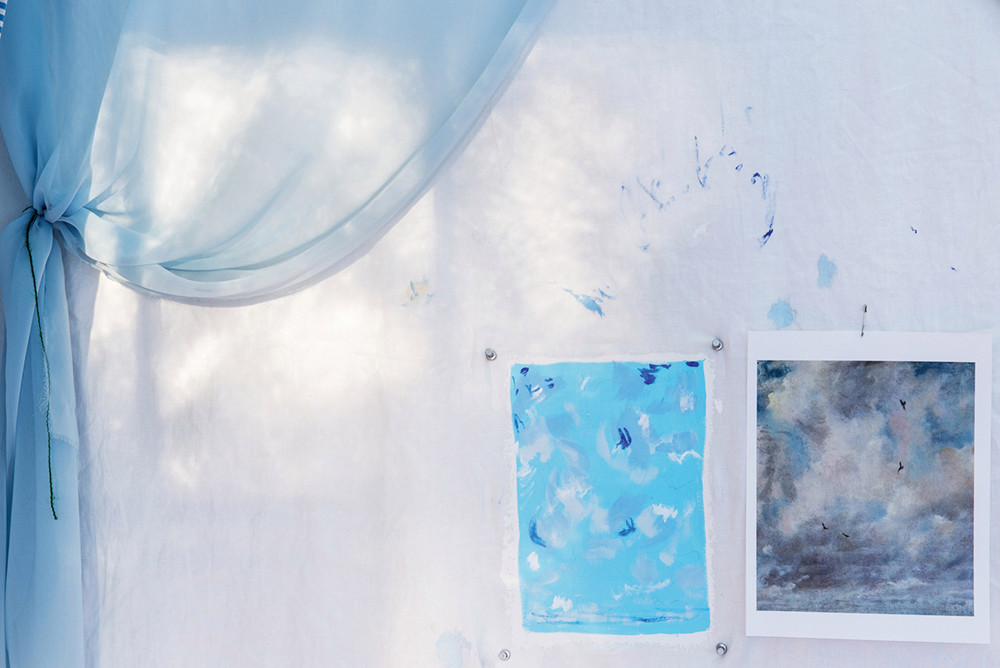[ad_1]
David Gilbert’s photographs depict arrangements he creates in his studio out of whatever happens to be on hand: scrap paper, found detritus, fabric, string, cardboard, and organic matter like branches and flowers. Photographed in soft natural light, his everyday materials take on a heft and drama they might lack if encountered in person. Like vacant theatrical sets, his compositions are self-contained worlds that hint at possible occupants: if we stare long enough, it seems, something just might happen.
The eight photographs in Gilbert’s exhibition “Painted Ladies” (all 2019) play fast and loose with art historical precedent, much like the glamorous architectural anachronisms evoked by the show’s title: San Francisco’s famous Victorian houses, whose brightly painted facades are fanciful 1960s reinterpretations of a nineteenth-century style. Gilbert took the photographs during a residency at Yaddo, where he had to work with a fixed repertoire of props, maximizing limited resources. Certain elements, like a piece of butcher paper painted with black stripes and a veil’s length of gauze, are ripped up and repurposed across multiple arrangements, the modest components used to create effects suggestive of both neoclassical portrait sittings and plein air painting. Like a drag queen fashioning a gown out of trash, Gilbert proves glamour is not so much about what you have as what you do with it.
A particularly striking trio of works features compositions that center on hanging forms: in Painted Lady, a length of white gauze dappled in paint is suspended from a bunched ball of reddish paper, the ghostly results uneasily recalling both a bride with her back turned and a freshly slaughtered chicken. By contrast, the roll of green-painted burlap with a slender piece of gauze hanging over it in Grande Dame forms an elegant silhouette recalling the couture worn by midcentury model Lisa Fonssagrives in photographs shot by her husband, Irving Penn. In Posy, a large silhouette of a flower cut out of butcher paper curls around itself like a sleeping bat.
Not all of the photographs feature such suggestive figural elements. Gilbert’s sumptuous handling of light is best appreciated in the more abstract works, which propose a middle ground between still life arrangements and landscapes. In Ether, for example, a swath of light-blue fabric hangs before a piece of white fabric beyond which we can make out the outlines of a window. As if nodding to the view obscured by his arrangement, Gilbert has inserted a printed reproduction of a cloud painting by John Constable next to his own roughly executed copy of the same work. Constable printouts are also visible in several other photographs, including Posy, where one is tacked onto a painted backdrop that seems inspired by it, with wispy strokes of pale blue on a wrinkled white ground.
Instead of a sly wink from copy to original, Gilbert’s juxtaposition of the Constable reproductions with his own clumsy homages suggests that both versions have aesthetic value, contributing equally to the composition as a whole. What matters is the total look. Constable once claimed to have never seen an ugly thing in his life, explaining that “light, shade, perspective” will always make the form of an object beautiful. Gilbert’s photographs seem to take Constable’s quip as a challenge, capturing, with great tenderness and care, the potential of even the humblest of materials to enchant, while revealing and reveling in the manufactured nature of such beauty.
This article appears under the title “David Gilbert” in the February 2020 issue, p. 93.
[ad_2]
Source link


